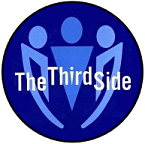The Third Side: Additional Resources for Providers

| Note Regarding External Links on This Page We are still in the process of converting the "external resource" links from our old computer system to our new one. Unfortunately, this is a time-consuming task which, because of limited funds, we are undertaking on a time-available basis. In the meantime, many of these references can be found by using our Search Plus External Links system. |
Additional Resources for Providers
Short Examples of Providers
- Meeting Needs to Save a Child - A story of how the provision of attention and love can help keep kids out of trouble.
- Helping People Lift Themselves Up - The story of the Grameen Bank which provides loans to poor people, allowing them to help themselves and giving them the self-esteem that comes from knowing someone trusts them.
- Prevention Efforts Lead to a Revitalization - The story of the revitalization of New York City between 1977 and 2003
- Community Mentor Program - Providing bonds between Hispanic youth and college students in Austin, Texas.
- Gang Warfare: Mothers as Thirdsiders - The story of a courageous group of mothers who provided "a space for peace" in a previous gang war zone of East Los Angeles.
- The Third Side: Collaborating to Deal with an Escalating School Problem - Describes how teachers and administrators in a high school played all ten third side roles to stop an escalating conflict between students.
Longer Case Studies of Providers and other Third Siders in Action
A number of case studies have been developed to exhibit:
- How the third side gets mobilized and becomes active; and
- What the most significant barriers to the third side's emergence are, and why these have proven so difficult to overcome.
These case studies are excellent resources for teachers, study groups, or others interested in the role of the provider (and other third-sider roles) in actual conflict situations.
- Tuzla, The Third Side, and the Bosnian War, by Joshua N. Weiss, Ph.D.
- The Role of Third Side in Peace Talk: Toward Effective Means of Dispute Resolution: The Case of the 1994 Nuclear Crisis between the United States and the DPRK, by Chang In Shin, Ph.D.
- Privatization in Germany: Lessons from a Third Side Case Study, by Mark Young
- Whose Land Is It Anyway?" The Third Side's Response to Indian Land Claim Conflicts in Upstate New York, by Brian Blancke and Bianca Wulff
- TB in Peru: How the Third Side Mobilized a Global Response to a Burgeoning Health Crisis, by Rebecca J. Wolfe
Internet Resources
- Do No Harm Project
- Grameen Bank (Mohammed Yunus) - "Grameen Bank (GB) has reversed conventional banking practice by removing the need for collateral and created a banking system based on mutual trust, accountability, participation and creativity. GB provides credit to the poorest of the poor in rural Bangladesh, without any collateral. At GB, credit is a cost effective weapon to fight poverty and it serves as a catalyst in the over all development of socio-economic conditions of the poor who have been kept outside the banking orbit on the ground that they are poor and hence not bankable. Professor Muhammad Yunus, the founder of Grameen Bank and its Managing Director, reasoned that if financial resources can be made available to the poor people on terms and conditions that are appropriate and reasonable, these millions of small people with their millions of small pursuits can add up to create the biggest development wonder."
- Project Hope - "The name Health Opportunities for People Everywhere (HOPE) is reflected in its mission: To achieve sustainable advances in health care around the world by implementing health education programs and providing humanitarian assistance in areas of need. Identifiable to many by the S.S. HOPE, the world's first peacetime hospital ship, Project HOPE now conducts land-based medical training and health care education programs on five continents, including North America. " - Organization Mission
- The Self Family Foundation - This organization is dedicated to helping to improve the quality of life for citizens of Greenwood and South Carolina.
- The Giraffe Project - The Giraffe Project is a story-based curriculum that teaches courageous compassion and active citizenship. It also provides an engaging and effective structure for service-learning, and for meeting community service requirements.
Print Resources
- Anderson, M. (1999) Do No Harm. Boulder, CO: Lynne Rienner. - The book's primary goal is to evaluate the use of aid by agency staff and recognize the conflicts they affect. While Anderson encourages aid staff to congratulate themselves where conflict is positively affected, she also calls upon them to step back and look more closely at the conflict situation that they are operating in to decrease the negative impact of aid. The target audience of this book includes aid agency staff and the wider international development community.
- Bornstein, D. (1997). The Price of a Dream: The Story of The Grameen Bank. Chicago: University of Chicago Press. -
- Burton, J. (1990). Conflict: Human Needs Theory. New York: St. Martin's Press.
- Gurr, T. (1970). Why Men Rebel. Boulder: Westview Press.
- Dollard, J., L. Doob, N.E. Miller, et al. (1939). Frustration and Aggression. New Haven: Yale University Press.
- Maslow, A. (1987). Motivation and Personality, Third Edition. New York: Harper and Row.
- Ury, William (2000). The Third Side: Why We Fight and How We Can Stop. New York: Penguin. - This book discusses the "Third Side" within situations of conflict: the human differences that lead to misunderstandings, disagreement, and conflict.
For More Information
- A Cautionary Note: Do No Harm
- A Provider's Checklist of Things to Think About
- Resources for Providers
- Third Sider Roles
- Main Third Side Page
Much of the material on this user guide is drawn from www.thirdside.org. Thanks to William Ury and Joshua Weiss for giving us permission to republish their material here.







